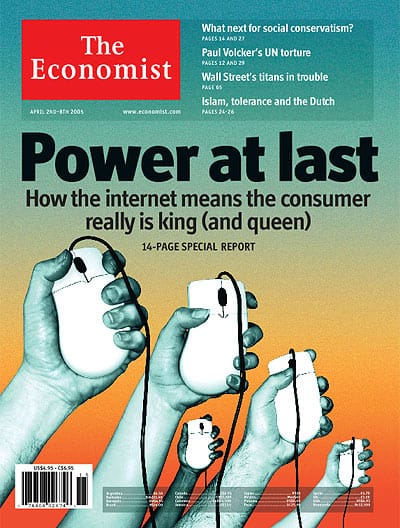
Just caught the last issue of The Economist with their feature and survey on “Consumer Power”. It makes pretty interesting reading for anyone working remotely close to the marketing/branding/advertising worlds and is confirmation that big media is starting to catch up with the ideas of the Hughtrain and the death of top-down media and advertising. Only a couple of years late then. Here’s one of Paul Markillie’s (the author) points:
“For some companies this is scary stuff—the same as throwing open your customer-relations files and hoping that people have said enough nice things about you. Companies can, of course, try to control everything that is said and written about them through advertising and public relations. But nowadays a web search can turn up all sorts of skeletons in the cupboard”
For designers this poses a real challenge. How do you design a logo for a brand that has become a conversation without it seeming like you’ve stamped your mark all over it and want to own it? The answer is you don’t. You create a language instead.
That’s exactly what Tomato has been up to with their work for Sony’s Connected Identity and Japan’s TV Asahi. Connected Identity is, quite literally, interactive and ever changing thanks to data and external inputs constantly evolving the logo.
The irony is, of course, that Sony’s world is only connected if you buy into their Memory Stick system and they’re notorious for their ham-fisted control of their brand. The other identity is for a TV Station - the archetypal top-down media controller. Which brings us back to the Hughtrain.
None of this is new though - Tomato also pitched a [similar idea]((http://www.tomato.co.uk/home/branding/channel.html) to Channel Four in the UK ten years ago. We worked with them to create an interactive pitch package, but nobody really got the idea of moving away from a “logo-centric” world-view. I didn’t, nor did Channel Four who went for something else. Kudos to Tomato for being so far ahead of their time - I certainly get it now.
What is useful is the research and statistics, so now it’s possible for these gut feelings to be supported by some real numbers. It’s looking grim for top-down branding and media networks. Forrester research found that 60% of programmes watched by DVR owners are recorded and that 92% skip the ads.
Almost as scary (for brands) is the figure that TNS Media Intelligence add 400-700 new brands to their tracking system (already tracking 2.1m brands) every day. Insane. Time to read Barry Schwartz’s “The Paradox of Choice”.

